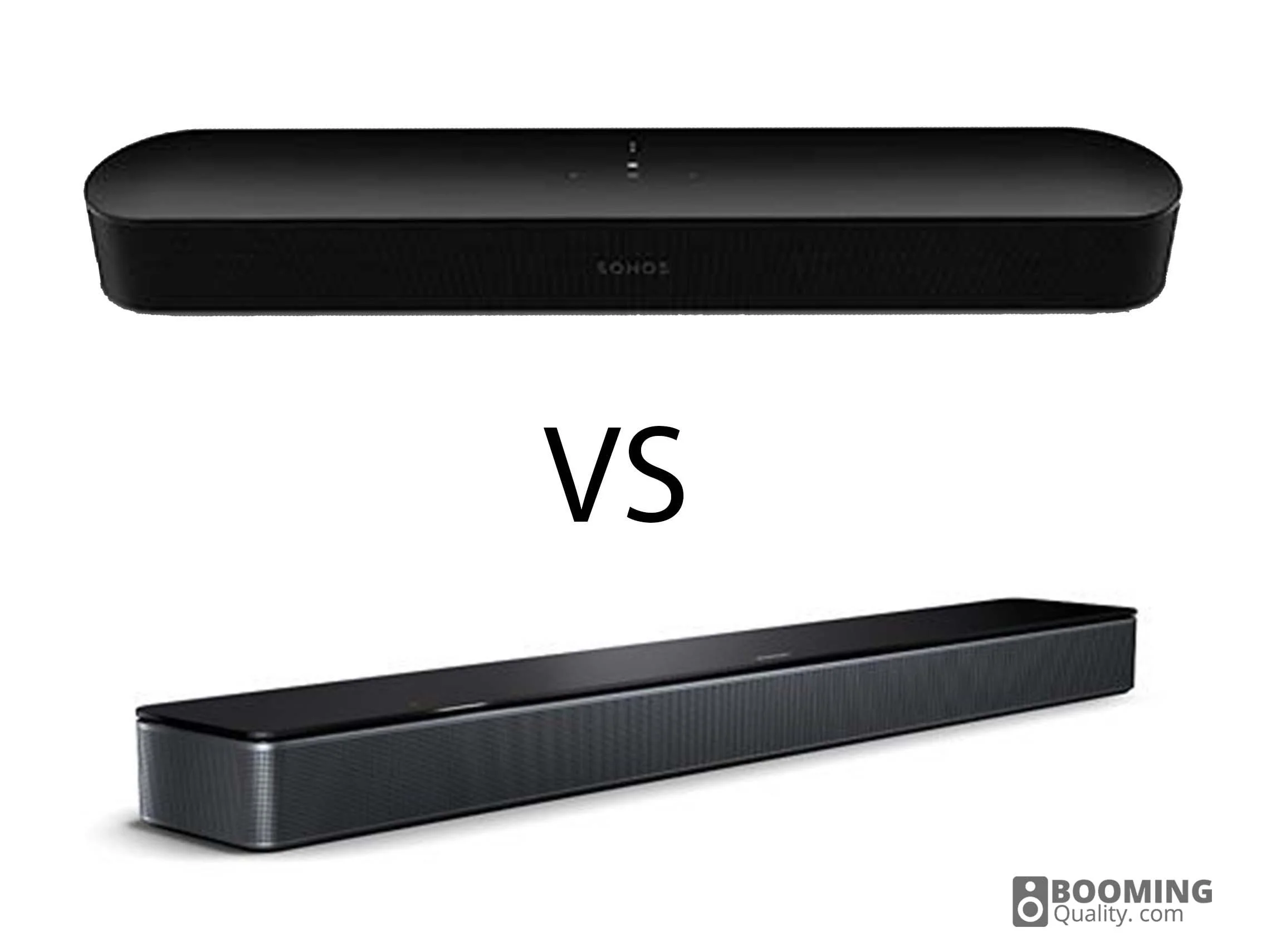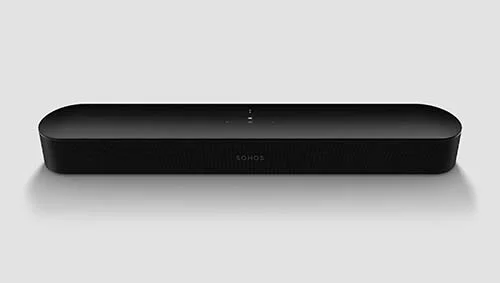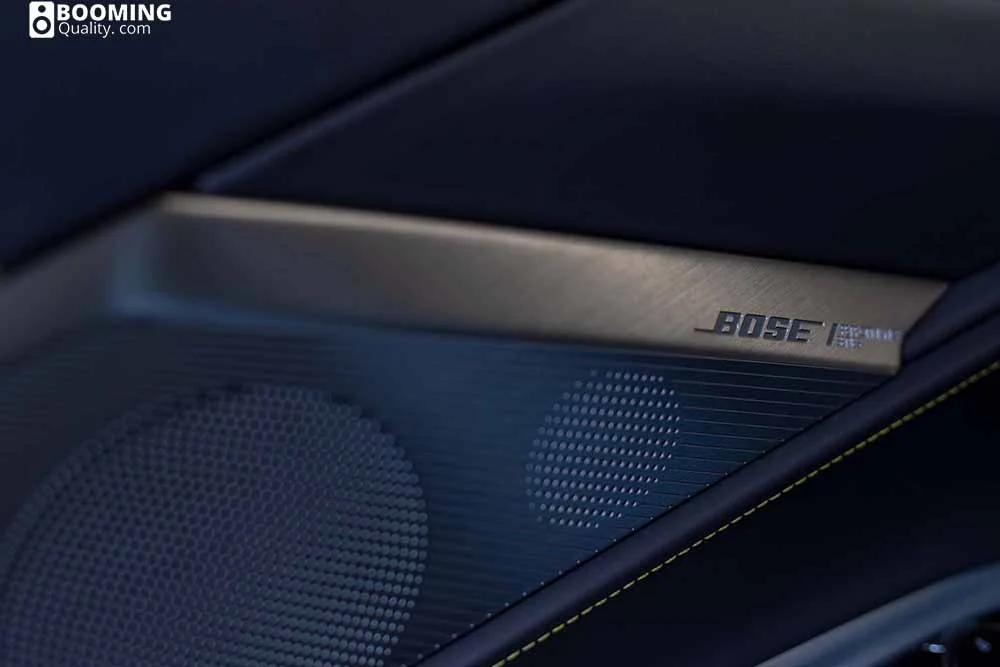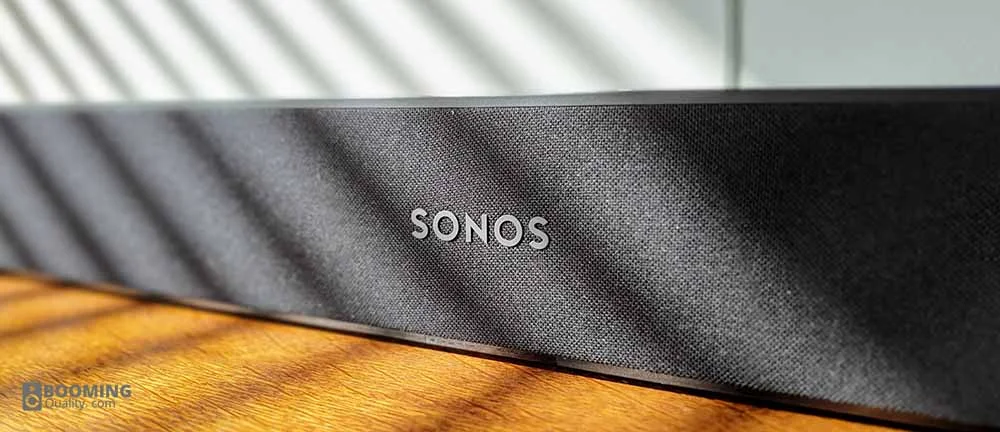We may earn a commission if you purchase through our affiliate links. This helps us continue to provide helpful content for you. Learn More

Which is better, Sonos Beam vs Bose Soundbar 300? We will find out by looking at factors of both soundbars such as design, sound quality, additional features, and price.
Of course, both models will have their strengths and weaknesses, but we aim to help you have a better understanding to help you make the best decision for your home setup.
Choosing the perfect soundbar can be hard but luckily we’re here to help you make an informed decision catered to your personal preferences.
Additionally, if you like our content, find out what the best soundbar to go with a projector. Let’s dive into the comparison!

Consider your specific preferences and needs—whether it’s immersive surround sound, sleek design, or seamless integration with smart home devices.
Delve into each soundbar’s unique features, from voice control capabilities to compatibility with your existing home theater setup.
Sonos Beam (Gen 2)

Overview
The Sonos Beam Gen 2 is a very popular choice in the soundbar world and Sonos’ latest soundbar to date. People generally love its compact design, only being around 65cm long it can pretty much fit anywhere neatly without causing an obstruction.
As far as sound quality goes, the Sonos Beam offers detailed highs and lows and feels very high-definition. However, it doesn’t come with a subwoofer so lacks a little bit of that boom.
If you have an Alexa or Google Assistant you’ll be happy to know you can link them with this soundbar so you can start to control features just by using your voice, which skips the stress of losing the remote.
Pros
- Dolby Atmos (Providing your TV is compatible with this) – A feature that adjusts the soundstage to fit your room and creates a surround sound feel without any added components. It’s also designed to be adaptive to the content being played and works with a wide range of apps and streaming services for a more 3-dimensional experience.
- Speech Enhancement Feature – This can amplify voices so you don’t miss any dialogue during action-packed scenes. It also provides a balanced sound no matter what volume, so it’s always clear and distortion-free at the highest volumes. The perfect option for those with hearing impairments.
- Night Sound Feature – This delivers balanced sound at any volume. Especially good for when you have to keep it down at night. This works by reducing the sound of explosions and gunshots and enhancing quieter sounds like dialogue.
- Wireless setup – Everything looks clean with no trip hazards as this is all connected via Wi-Fi, you can also add additional speakers without having trailing wires.
- Stress-Free Setup – With the step-by-step guide from the Sonos App you can be up and running with awesome sound quality in minutes.
Cons
- Limited Bass Performance – As this model doesn’t come with a matching subwoofer, the bass performance is delivered by the speaker. This could not provide the lows and depth compared to having a separate subwoofer, Despite its Bass Boost setting. The good news is Sonos does have a subwoofer model to purchase separately.
- Price – This might not be the best option for those on a tight budget as it is pricier than other options on the market.
- Limited Connectivity to Older Devices – As mentioned earlier if your TV doesn’t support Dolby Atmos this could limit your experience with the soundbar. This soundbar is designed to be used with newer-generation TVs, for instance, if you have to connect via an optical cable if your TV is not HDMI ARC compatible you could also lose some of the benefits this model offers, although still possible.
Bose Soundbar 300

Overview
Now let’s take a look at the Bose soundbar 300. It has a sophisticated design with a tempered glass top and metal grille.
The Bose Music App lets you take full control over your sound preference and allows you to adjust things like volume and bass levels easily from your phone or other devices.
It has a great range of dynamic and clear sound quality and a soundstage even wider than the Sonos Beam.
Unfortunately, you cannot connect your Amazon Alexa or Google Assistant to the Bose 300 Soundbar but it does however have its own Alexa/Google Assistant built-in for hands-free voice control.
If you already have this model, read our guide on how to hook up Bose soundbar to TV
Pros
- 5 Full-Range Drivers – These drivers create a more balanced, natural sound experience with a range of high and low frequencies. They are positioned in a way to create a wide soundstage and produce more sound with less power than your average driver.
- Built-In Alexa – Although there is no integration for existing Alexa/Google Assistant, there is already a built-in voice control option that can be used for different commands.
- Multiple Connectivity Options – As well as the usual HDMI ARC and optical cable connections you see with a lot of soundbars it also has several other options to connect audio. These include Bluetooth, Wi-Fi, and Aux which help connect various devices with no issue about how old they are.
- Stress-Free Setup – The setup process is designed to be easy and hassle-free. You can read some instructions in our article Bose setup for more information. The instructions and the automatic sound calibration allow you to get up and running quickly and easily.
- Bose Music App – It’s a handy app that allows you to do some basic controls and customizations from your phone. This is also useful for updating the firmware on your soundbar to ensure it’s all up to date.
Cons
- Limited Bass Performance – The soundbar relies on its drivers to produce the lower frequencies, although it does this well it lacks the accuracy and impact of the lowest frequency a stand-alone subwoofer would provide.
- Price -The Bose Soundbar 300 is priced higher than other soundbars and similar to the Sonos Beam it is only compatible with other Bose products which can be also pricey.
- Limited Sound Customization – This model does not offer basic EQ controls such as adjusting mid-range frequencies or the bass and treble levels. However, it is worth noting it has already been designed to create a well-balanced, adaptive sound but others may like a more customizable experience.
Design and Build Quality: Comparison
When it comes to choosing a soundbar, aesthetics and build quality play a significant role, as they determine how well the soundbar blends into your living space. Let’s compare the design and build quality of the Sonos Beam and Bose Soundbar 300 to help you make an informed decision.
Sonos Beam (Gen 2)
The Sonos Beam (Gen 2) boasts a sleek and modern design that fits seamlessly into contemporary home setups. Its compact form factor and minimalist aesthetics make it suitable for various room styles. The build quality is top-notch, featuring a premium feel with a robust grille covering the front.
One notable feature is its touch-sensitive controls on the top panel, allowing for easy volume adjustments and playback control without needing a remote. The Beam (Gen 2) also comes in two color options: black and white, providing flexibility to match your room’s decor.
Bose Soundbar 300
The Bose Soundbar 300 offers a similarly sleek design, with a narrow profile that enhances its compatibility with various TV sizes. It features a tempered glass top that adds a touch of sophistication to its appearance. The build quality is solid, ensuring durability over time.
Like the Sonos Beam, the Soundbar 300 also comes with touch-sensitive controls on the top panel for convenient operation. However, it stands out with its optional Bose Bass Module and Surround Speakers that can be added for a more immersive audio experience.
Comparison
Both soundbars excel in design and build quality, catering to users with different aesthetic preferences. While the Sonos Beam (Gen 2) offers a minimalist design and color options to blend with your decor, the Bose Soundbar 300 adds a touch of elegance with its glass top.
The choice between the two ultimately depends on your room’s style and personal design preferences.
In terms of build quality, both soundbars are durable and built to last, ensuring you can enjoy high-quality sound for years to come.
Consider your room’s aesthetics and how each soundbar complements your existing setup when making your decision.
For us, The Sonos Beam (Gen 2) takes the lead with its striking aesthetics. Its ability to seamlessly blend into any room’s decor while maintaining a premium look and feel makes it a clear winner in this aspect.
Connectivity and Compatibility: Comparison
When evaluating the connectivity and compatibility of two leading soundbars, such as the Sonos Beam (Gen 2) and the Bose Soundbar 300, it’s crucial to consider how well they integrate into your existing audio setup and smart home ecosystem.
Sonos Beam (Gen 2)
- HDMI ARC/eARC: The Beam features an HDMI ARC (Audio Return Channel) port, which simplifies the connection to your TV and allows for CEC (Consumer Electronics Control) compatibility, enabling you to control the soundbar with your TV remote. With eARC support, it can handle high-resolution audio formats for an enhanced listening experience.
- Optical Audio Input: If your TV lacks HDMI ARC/eARC, the optical audio input provides an alternative connection method, ensuring compatibility with a broader range of televisions.
- Apple AirPlay 2: For Apple users, the Sonos Beam supports AirPlay 2, allowing you to stream content directly from your Apple devices, including iPhones, iPads, and Macs.
- Voice Assistants: The Beam (Gen 2) is compatible with both Amazon Alexa and Google Assistant. This means you can control your soundbar using voice commands, access information, and manage your smart home devices with ease.
- Multiroom Audio: If you have other Sonos speakers, you can create a multiroom audio system, allowing you to play music throughout your home.
Bose Soundbar 300
- HDMI ARC/eARC: Like the Beam, the Soundbar 300 includes an HDMI ARC port for straightforward TV connection and CEC compatibility. However, it may not support eARC for high-resolution audio formats.
- Bluetooth: The Soundbar 300 features Bluetooth connectivity, enabling you to stream music directly from your mobile devices.
- Voice Assistants: While it doesn’t have built-in voice assistants, the Soundbar 300 can be integrated with Amazon Alexa or Google Assistant via external devices like Echo Dot or Google Nest speakers.
- Bose Music App: Bose offers a dedicated app, the Bose Music app, which allows you to control the soundbar, adjust settings, and manage your music sources.
Comparison
Both the Sonos Beam (Gen 2) and Bose Soundbar 300 offer essential connectivity options, but the Sonos Beam shines in terms of smart home integration and voice assistant support.
Its compatibility with multiple voice assistants and Apple AirPlay 2 makes it a versatile choice for those invested in different ecosystems. Additionally, the ability to create a multiroom audio system with other Sonos speakers adds to its appeal.
The Bose Soundbar 300 provides solid connectivity options, though it may not be as deeply integrated into the smart home ecosystem as the Sonos Beam and it may require external devices for voice assistant integration.
In summary, the choice between the two soundbars depends on your specific connectivity and compatibility needs. If you prioritize seamless integration with smart home devices and multiple voice assistants, the Sonos Beam (Gen 2) is the standout choice.
On the other hand, the Bose Soundbar 300 offers reliable connectivity options and may be suitable for those seeking simplicity in their audio setup.
Remote Control and App Functionality: Comparison
In the world of soundbars, the convenience of remote control and app functionality can greatly enhance your user experience. Let’s compare how the Sonos Beam (Gen 2) and the Bose Soundbar 300 fare in these aspects.
Sonos Beam (Gen 2)
- Physical Remote: The Beam (Gen 2) includes a dedicated physical remote control. It provides intuitive access to essential functions such as volume adjustment, playback control, and input selection. The remote’s simplicity makes it easy for users of all ages to operate.
- Smartphone App: Sonos provides a user-friendly smartphone app, available for both iOS and Android devices. This app allows you to control the soundbar, adjust audio settings, and manage your entire Sonos ecosystem, including other speakers you may have. It’s a convenient hub for accessing music services, setting up your sound system, and configuring settings.
- Voice Control: With built-in support for Amazon Alexa and Google Assistant, you can control the Sonos Beam (Gen 2) using voice commands. This feature extends beyond just audio control, as you can ask for information, set alarms, or control your smart home devices.
- Apple AirPlay 2: For Apple enthusiasts, the Beam supports AirPlay 2, enabling you to stream music directly from your Apple devices and use Siri voice commands for playback control.
Bose Soundbar 300
- Physical Remote: Bose includes a physical remote control with the Soundbar 300. It provides access to essential functions like volume adjustment, input selection, and playback control. The remote is designed for simplicity and ease of use.
- Bose Music App: Bose provides the Bose Music app, available for iOS and Android devices. This app allows you to control the soundbar, adjust settings, and manage your music sources. While functional, the app may not offer the same level of ecosystem control as the Sonos app.
- Voice Assistant Integration: The Soundbar 300 can be integrated with Amazon Alexa or Google Assistant via external devices like Echo Dot or Google Nest speakers for voice control.

Price and Value for Money: Comparison
When choosing between two premium soundbars like the Sonos Beam (Gen 2) and the Bose Soundbar 300, pricing and value for money become essential considerations. Let’s delve into how these soundbars compare in terms of their cost and the value they offer.
Sonos Beam (Gen 2) – $400 – $600 (Estimation Based on Listings)
These are a few key features that Sonos Beam offers for its price tag –
- Sound Quality: The Beam is praised for its clear and balanced sound, making it an excellent choice for both movies and music. The addition of Dolby Atmos support in the Gen 2 model enhances the audio experience further.
- Smart Home Integration: Sonos’ commitment to smart home integration, including voice assistant support, allows the Beam to be a central part of your connected home. Its compatibility with Amazon Alexa and Google Assistant adds value by extending its functionality beyond just audio playback.
- Build Quality: The Beam (Gen 2) boasts a premium build with durability in mind, promising longevity and reliability.
- Ecosystem: If you already have other Sonos speakers, the Beam can seamlessly integrate into your Sonos ecosystem, creating a versatile multiroom audio setup.
Bose Soundbar 300 – $400 – $600 (Estimation Based on Listings)
The Bose Soundbar 300 is also positioned in the premium soundbar category. Pricing may vary, but it typically falls within the mid to high price range, similar to the Sonos Beam.
Here are some of the key features the Bose offers for its price.
- Audio Quality: Bose is renowned for its audio quality, and the Soundbar 300 delivers impressive sound with clarity and depth, enhancing your overall viewing and listening experience.
- Brand Reputation: Bose is a trusted name in the audio industry, and its products often come with a reputation for quality and reliability.
- Sleek Design: The Soundbar 300’s design, including the tempered glass top, adds a touch of elegance to your home theater setup.
Are They Worth It?
Ultimately, Both the Sonos Beam (Gen 2) and Bose Soundbar 300 offer premium audio experiences, which is reflected in the price.
When it comes to value for money, your decision between these two soundbars should consider personal preferences:
- If you prioritize deep smart home integration, a versatile ecosystem, and customizable sound options, the Sonos Beam (Gen 2) may offer more value for tech-savvy users.
- If you lean towards a trusted brand known for audio quality and appreciate a sleek design, the Bose Soundbar 300 might be your preferred choice.
Ultimately, value for money depends on your specific needs and priorities in a soundbar. Consider the features and qualities that matter most to you when making your decision.
Sonos Beam VS Bose Soundbar 300: Comparision
When comparing the two models, both are serious competitors in the audio world. Both models are great choices for a home cinema setup and each has its own strengths.
Both the Sonos Beam and Bose 300 have clear dialogue and impressive sound overall. However, the Sonos Beam has the advantage of Dolby Atmos, creating a more immersive 3D soundstage than the Bose.
In saying that, the Bose does have a wider, more powerful soundstage, and more powerful bass performance out of the two, but as previously mentioned both are quite lacking in the bass department.
The Bose has a wide range of connectivity options such as HDMI ARC, Optical, Aux, and Wi-Fi and the Bose 300 also includes Bluetooth support which is something the Sonos Beam does not. The Sonos only offers limited connectivity and pretty much relies on you having up-to-date technology to connect and use it with.
Both soundbars can be controlled by apps and voice assistants, although the Bose 300 has more limited sound customization controls.
In terms of design, the Sonos Beam is very modern-looking and compact, measuring only around 64 cm long and weighing 4.4 pounds. The Sonos Beam’s size is very comparable to the Bose which is around 67 cm long but weighs double the amount at 8.09 pounds.
The Beam has more of a modern feel as the buttons are touchscreen on the top of the soundbar whereas the Bose is more classic with physical buttons.
Overall, looking at the two soundbars both have a lot to offer and are impressive competitors. It all boils down to what qualities you look for in a soundbar and your personal sound preferences that will give either one the edge.
Summary: Sonos Beam or Bose Soundbar 300? What We Think
In conclusion, as mentioned before it is down to your own personal preferences and what you favor in a soundbar to find the best out of these two models.
We are going to give a summary based on our preferences and experiences with both soundbars.
Out of both soundbars, we think the Sonos Beam Gen 2 is better than the Bose soundbar. Whilst both soundbars offer a great quality of sound and a range of features, we think the Sonos Beam is the better one for most users.
Its Dolby Atmos support and sound customization options provide a more immersive audio experience, whilst being compact and neat, making it easy to tuck away.
We also like the option of a different color with the white model to best suit your style and decor, with the touchscreen buttons giving a more stylish feel compared to the Bose. We think the beam is a darker black than the Bose which disguises itself nicely.
Moreover, the Sonos focuses on multi-room so doesn’t include Bluetooth support whereas the Bose does, having a slight edge in that department.
However, we found the setup user-friendly, hassle-free, and easy to set up with existing Sonos models using the convenient Sonos ecosystem.
To set up your Sonos Beam follow this guide.
Making Your Decision
So… You’ve heard what we think and the different breakdowns of each soundbar focusing on features, design, price point, and more…
Ultimately, when making your decision your choice should align with your specific needs and priorities. Consider what aspects of audio quality, smart home integration, design, and ecosystem compatibility matter most to you.
Both the Sonos Beam (Gen 2) and Bose Soundbar 300 are reputable options that can elevate your home audio experience, so rest assured that you’re choosing between two excellent soundbars.
Choosing between the Sonos Beam (Gen 2) and the Bose Soundbar 300 is no easy task, as both soundbars offer their unique strengths and cater to different preferences.
The best thing is to read comparison reviews such as ours to get full information and a fully formed, realistic expectation of both of the soundbars to make the best choice for you.

FAQs
Is it worth buying Bose Soundbar 300?
We think the Bose soundbar has a lot of good qualities and stand-out features over other soundbars in this price range. However, whether it is worth buying or not is down to what your preferences are and what soundbar features you prioritize the most for your setup.
If you prioritize an easy setup process, powerful sound, and multiple connectivity options then this soundbar can happily provide all those things for you.
If you prioritize deeper bass and a lot of sound customization you may be disappointed with this soundbar.
Is Bose 300 loud?
This soundbar can produce a maximum of 95 decibels which is quite loud and should be more than enough for most home entertainment systems.
It’s important to follow Bose’s guide for placement and setup to get the most out of the soundbar as things such as positioning and orientation can affect how loud the model can go.
What is the alternative to Bose Soundbar 300?
There are a few alternatives on the market comparable by price and quality. These soundbars are:
Sonos Beam, which is compared to the Bose in this article.
Vizio M-Series M512a-H6
Yamaha YAS-209
Samsung HW-T450
LG SK1
These soundbars offer similar features and performance that are comparable with the Bose soundbar 300. All of course have their strengths and weaknesses, so it’s important to consider preferences and needs when choosing the best option for you.

Written By Emily
If you liked this comparison article, check out the best outdoor soundbar!
